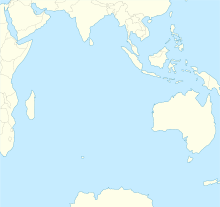Christmas Island International Airport (IATA: XCH, ICAO: YPXM) is an airport located on Christmas Island,[1] a territory of Australia in the Indian Ocean. The island is located 2,600 km (1,600 mi) northwest of the Western Australian city of Perth, 500 km (310 mi) south of the Indonesian capital, Jakarta, and 975 km (606 mi) east-northeast of the Cocos (Keeling) Islands.
Christmas Island International Airport | |||||||||||
|---|---|---|---|---|---|---|---|---|---|---|---|
 | |||||||||||
 | |||||||||||
| Summary | |||||||||||
| Airport type | Public | ||||||||||
| Operator | Toll Remote Logistics | ||||||||||
| Location | Christmas Island | ||||||||||
| Elevation AMSL | 916 ft / 279 m | ||||||||||
| Coordinates | 10°27′02″S 105°41′25″E / 10.45056°S 105.69028°E | ||||||||||
| Website | christmasislandairport | ||||||||||
| Maps | |||||||||||
 | |||||||||||
 | |||||||||||
| Runways | |||||||||||
| |||||||||||
| Statistics (2017/18) | |||||||||||
| |||||||||||

Located in an Australian territory, the airport is classified as a Category 2 international airport for all arrivals, including those from Australia. It is owned by the Commonwealth through the Department of Infrastructure and Regional Development and is operated under contract by Toll Remote Logistics.
History edit
From the late 1940s, when the island was still a British colony administered by Singapore and the Straits Settlements Administration, it was serviced occasionally by Royal Air Force (RAF) Short Sunderland flying boats before the construction of the airport [when?].[citation needed]
Tampa affair edit
A brief revival of activity at the airport occurred in 2001 during the Tampa affair when the heightened Royal Australian Air Force (RAAF) traffic was complemented by a large number of Department of Immigration and Citizenship (DIAC) and media charters. During this incident, traffic at the airport is said to have been "near-continuous".
Satellite launch facility edit
After the closure of the casino, the resort was taken over by the Asia Pacific Space Centre, which developed plans for a satellite launch facility on Christmas Island. The company, with solid financial participation from the Australian Government, had planned to start satellite launches in 2004.[citation needed] Technical staff was to include 350–400 Russian rocket scientists and engineers, and componentry was to be flown in on Antonov An-124 and Boeing 747 freighters. To achieve this, the airport would need major extensions, and the Government allocated around A$55m to the task. This included a 600 m (1,969 ft) runway extension, plus additional taxiways, apron space, and other infrastructure.
Facilities edit
Runway edit
The airport resides at an elevation of 916 ft (279 m) above sea level. It has one runway designated 18/36 with an asphalt surface measuring 2,103 m × 45 m (6,900 ft × 148 ft).[1] and a 2.3% mid-runway gradient.
Terminal edit
As the Indian Ocean Territories Islands are duty-free, the airport terminal has a Duty-free shop and licensed kiosk. In 2018 the airport operator, Toll Remote Logistics, introduced complimentary public Wi-Fi. This was the first time Wi-Fi had been offered for free at the airport on an island that only has a 2G mobile network.
Airlines and destinations edit
| Airlines | Destinations |
|---|---|
| Batik Air Malaysia | Charter: Kuala Lumpur–International[3] |
| Garuda Indonesia | Charter: Jakarta–Soekarno–Hatta |
| Toll Global Express | Cocos (Keeling) Islands, Perth |
| Virgin Australia Regional Airlines | Cocos (Keeling) Islands, Perth |
Traffic to and from the airport varies greatly. Along with regular flights to the Australian mainland, the airport receives weekly open charter flights from Jakarta with Garuda Indonesia and fortnightly open charter flights from Kuala Lumpur with Batik Air Malaysia. Historically airlines such as Indonesia AirAsia, Malaysia Airlines and SilkAir travelled to the island.[citation needed] Tourist attractions such as the migration of the Christmas Island red crab and the island's Christmas Island Resort have caused spikes in traffic levels. The construction of an immigration detention centre on the island resulted in a temporary increase in RAAF and DIMIA arrivals.[citation needed]
Statistics edit
Christmas Island International Airport served 26,723 revenue passengers during financial year 2017–2018.[4][2]
Graphs are unavailable due to technical issues. There is more info on Phabricator and on MediaWiki.org. |
| Year[4] | Revenue passengers | Aircraft movements |
|---|---|---|
| 2001–02 | 6,515 |
229
|
| 2002–03 | 8,778 |
303
|
| 2003–04 | 7,504 |
249
|
| 2004–05 | 8,125 |
255
|
| 2005–06 | 8,093 |
256
|
| 2006–07 | 8,072 |
262
|
| 2007–08 | 8,594 |
412
|
| 2008–09 | 6,665 |
246
|
| 2009–10 | 14,287 |
395
|
| 2010–11 | 27,286 |
428
|
| 2011–12 | 37,305 |
623
|
| 2012–13 | 65,383 |
1,008
|
| 2013–14 | 60,099 |
818
|
| 2014–15 | 31,499 |
396
|
| 2015–16 | 25,533 |
285
|
| 2016–17 | 25,615 |
318
|
| 2017–18 | 26,723 |
347
|
Fees and Charges edit
Fees and charges at the airport are set by the Commonwealth of Australia and are considerably higher than other airports, especially for small aircraft. The high cost per movement for aircraft less than 20,000kg of AUD $300 effectively ensures that scenic flights and smaller aircraft use is discouraged.
See also edit
References edit
Notes edit
- ^ a b c YPXM – Christmas Island (PDF). AIP En Route Supplement from Airservices Australia, effective 21 March 2024, Aeronautical Chart Archived 11 April 2012 at the Wayback Machine
- ^ a b c "Airport Traffic Data 1985–86 to 2010–11". Bureau of Infrastructure, Transport and Regional Economics (BITRE). May 2012. Archived from the original on 24 March 2012. Retrieved 27 June 2012. Refers to "Regular Public Transport (RPT) operations only"
- ^ "Malindo Air files Christmas Island charter schedule from Dec 2016". Retrieved 2 May 2018.
- ^ a b Fiscal year 1 July – 30 June
Further reading edit
- McGrath, Tony (2019). In Tropical Skies: A History of Aviation to Christmas Island and Cocos (Keeling) Islands. Carlisle, WA: Hesperian Press. ISBN 9780859057561.

